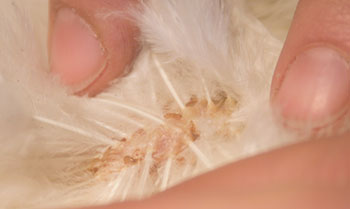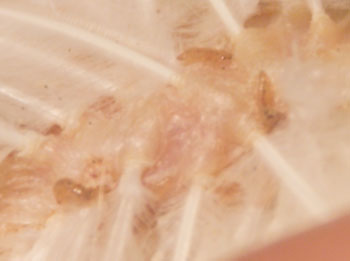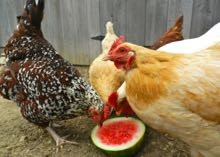Taking care of animals is not for the squeamish.
Last night, terribly worried about Snowball, I emailed a HenCam friend in England. I mentioned Snowball’s pale-pink comb. She said that it sounded like anemia and had I checked for lice? (Some types of lice eat dandruff and feathers, but others suck blood.) I had looked Snowball over – I checked the skin around her neck and across her back. I looked for the sort of lice I’ve seen before. Nothing.
But, it turns out that there are lice that only feed near the vent. They are pale – the color of Snowball’s feathers. When I picked her up and turned her over, there they were, swarming.

Poor Snowball!
Here’s a close-up. Just looking at it will make you itchy.
Lice that feed on birds do not like humans. Thank goodness! But, I’m still scratching my scalp.

I checked the other hens. A few of the girls have lice, nothing though, like the masses on Snowball. Buffy, already sick, had the most.
This morning I was at the feed store when it opened and picked up a can of louse powder, came home and dusted Buffy and Snowball. Yes, nasty chemicals. But it works, fast, and I’d rather have a live chicken that a dead organic one. Snowball and Buffy are in the spa. They don’t lay eggs, but if they did, I’d discard any eggs laid within a week after treatment.
An organic product that does keep lice in check is feed-grade diatomaceous earth (DE). My local feed store has ordered it for me, and I’ll have a 50 pound bag on Thursday. It will go in the dirt areas where the chickens bathe. DE has sharp little edges (seen under a microscope) and it causes the lice to dehydrate and die.
I’ll also clean out the coops and wash with a bleach/water mixture. The nesting boxes will be cleaned and set in the sun (a very effective disinfectant.)
So, Little Pond Farm will see some serious springtime cleaning.
